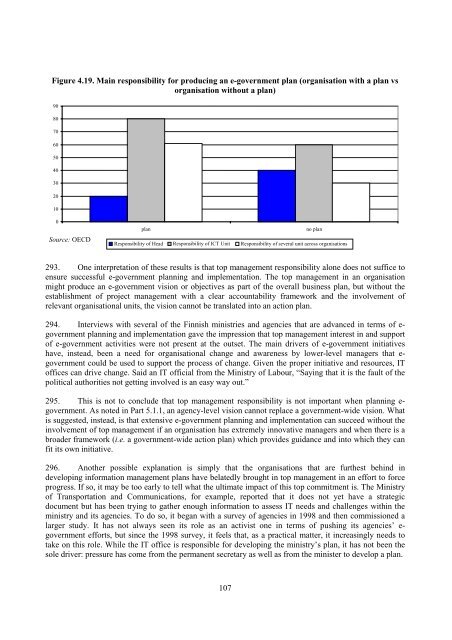e-GOVERNMENT IN FINLAND - ePractice.eu
e-GOVERNMENT IN FINLAND - ePractice.eu
e-GOVERNMENT IN FINLAND - ePractice.eu
You also want an ePaper? Increase the reach of your titles
YUMPU automatically turns print PDFs into web optimized ePapers that Google loves.
Figure 4.19. Main responsibility for producing an e-government plan (organisation with a plan vs<br />
organisation without a plan)<br />
90<br />
80<br />
70<br />
60<br />
50<br />
40<br />
30<br />
20<br />
10<br />
0<br />
Source: OECD<br />
plan no plan<br />
Responsibility of Head Responsibility of ICT Unit Responsibility of several unit across organisations<br />
293. One interpretation of these results is that top management responsibility alone does not suffice to<br />
ensure successful e-government planning and implementation. The top management in an organisation<br />
might produce an e-government vision or objectives as part of the overall business plan, but without the<br />
establishment of project management with a clear accountability framework and the involvement of<br />
relevant organisational units, the vision cannot be translated into an action plan.<br />
294. Interviews with several of the Finnish ministries and agencies that are advanced in terms of egovernment<br />
planning and implementation gave the impression that top management interest in and support<br />
of e-government activities were not present at the outset. The main drivers of e-government initiatives<br />
have, instead, been a need for organisational change and awareness by lower-level managers that egovernment<br />
could be used to support the process of change. Given the proper initiative and resources, IT<br />
offices can drive change. Said an IT official from the Ministry of Labour, “Saying that it is the fault of the<br />
political authorities not getting involved is an easy way out.”<br />
295. This is not to conclude that top management responsibility is not important when planning egovernment.<br />
As noted in Part 5.1.1, an agency-level vision cannot replace a government-wide vision. What<br />
is suggested, instead, is that extensive e-government planning and implementation can succeed without the<br />
involvement of top management if an organisation has extremely innovative managers and when there is a<br />
broader framework (i.e. a government-wide action plan) which provides guidance and into which they can<br />
fit its own initiative.<br />
296. Another possible explanation is simply that the organisations that are furthest behind in<br />
developing information management plans have belatedly brought in top management in an effort to force<br />
progress. If so, it may be too early to tell what the ultimate impact of this top commitment is. The Ministry<br />
of Transportation and Communications, for example, reported that it does not yet have a strategic<br />
document but has been trying to gather enough information to assess IT needs and challenges within the<br />
ministry and its agencies. To do so, it began with a survey of agencies in 1998 and then commissioned a<br />
larger study. It has not always seen its role as an activist one in terms of pushing its agencies’ egovernment<br />
efforts, but since the 1998 survey, it feels that, as a practical matter, it increasingly needs to<br />
take on this role. While the IT office is responsible for developing the ministry’s plan, it has not been the<br />
sole driver: pressure has come from the permanent secretary as well as from the minister to develop a plan.<br />
107
















